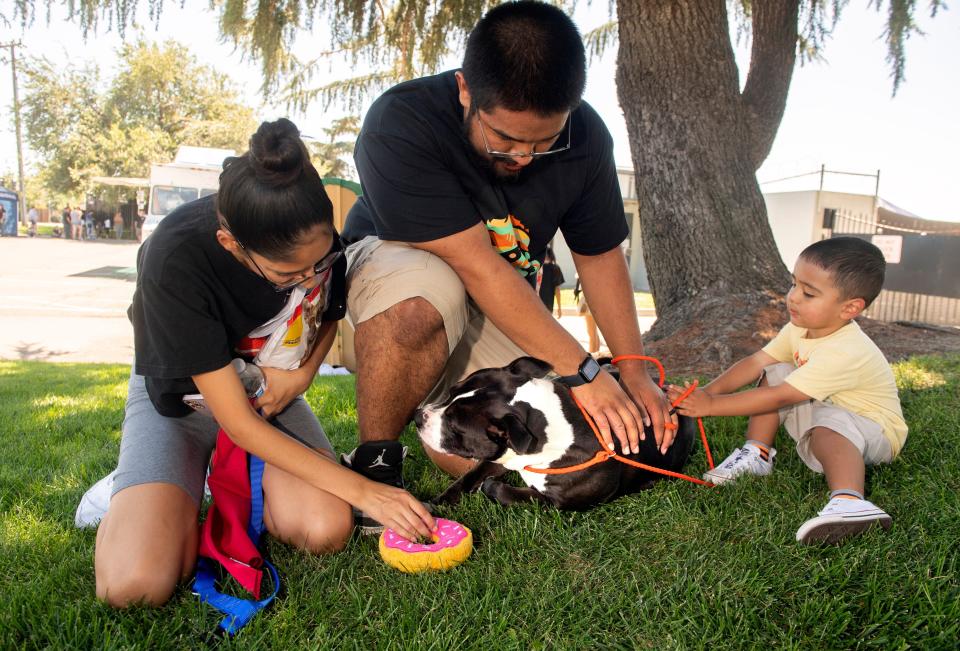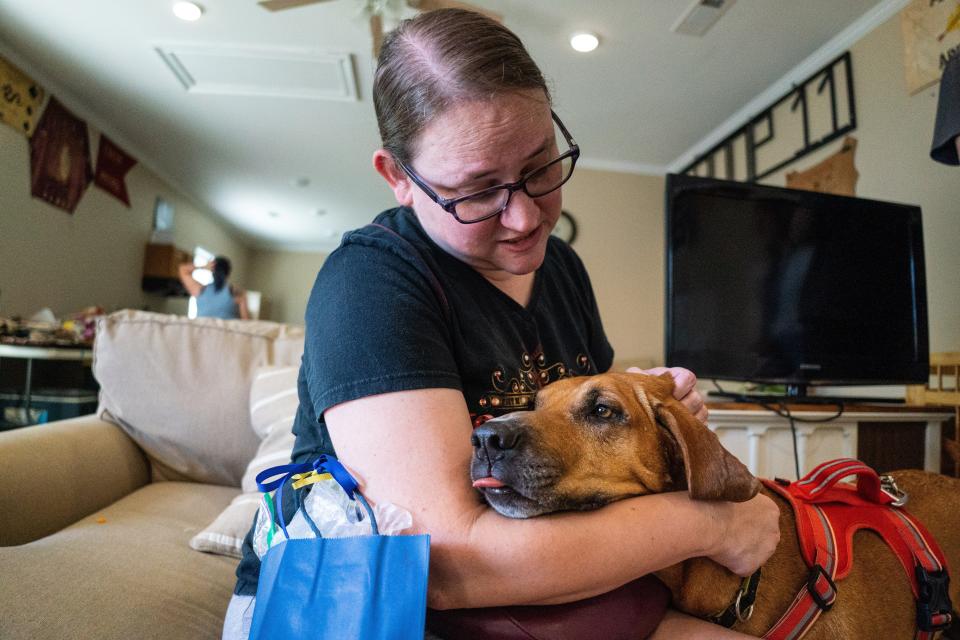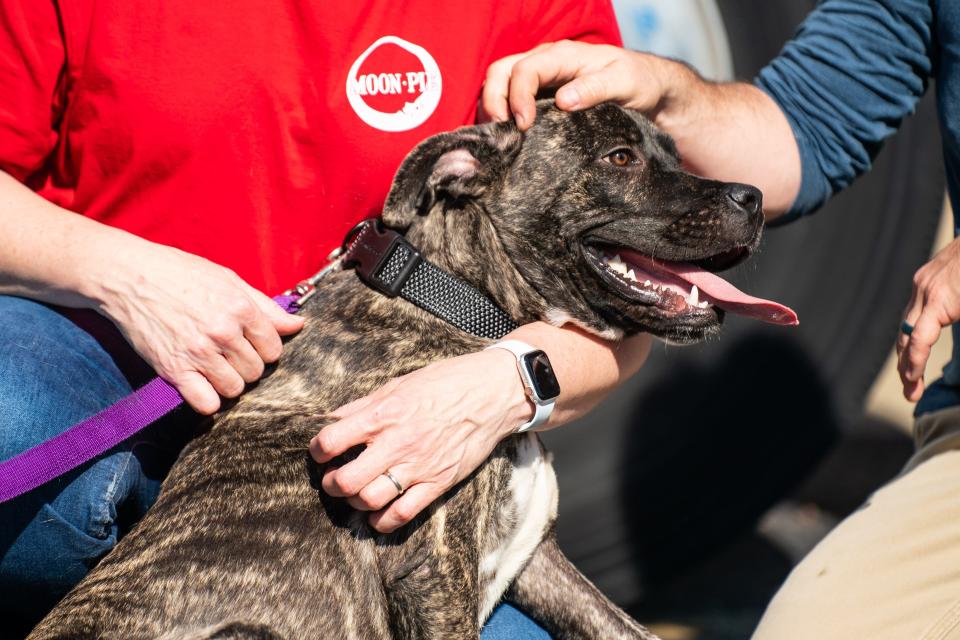‘Nationwide crisis’: Facing lower adoption rates, some shelters reconsidering euthanasia policies
After contracting in August 2020 to become the animal shelter for Ohio’s Hamilton County, Cincinnati Animal Care found 85 of its 100 kennels immediately full.
“We came in with a full shelter on Day One,” said Ray Anderson, community engagement manager for the facility, the largest in southern Ohio.
The numbers have only gotten worse in 2022, despite emergency overflow kennels from the county, Anderson said. By mid-November, the facility housed 200 dogs, some in temporary crates.
“We’ve since gotten the population down to 160, but we’re still over capacity,” Anderson said this week. While dogs housed in pop-up crates are moved into emergency kennels as soon as they open up, “we’ve gotten close to the point where we’re talking about housing multiple animals in a single kennel, and that’s not safe for dogs or volunteers.”
Like Cincinnati Animal Care, many shelters across the country are facing overcapacity, with some making space-based euthanasia decisions for the first time in years as more owners surrender their dogs because of inflation concerns and job loss.
Police bust alleged 'puppy mill': Find 180 animals living in 'horrible' conditions in New Jersey

The crisis is especially acute for municipal animal shelters, a situation one national animal welfare agency attributes to subpar adoption rates at private shelters, leaving municipal agencies shouldering a disproportionate portion of the load.
“We’ve made huge progress in terms of animals not being killed in shelters,” said Marc Peralta, chief program officer for Best Friends Animal Society, a national animal-welfare agency based in Utah. “That’s a good thing, but you can’t just hold on to them. You have to take more active measures.”
The situation has been exacerbated by high inflation and staffing shortages that have put many shelters behind the eight ball in terms of addressing overpopulation. An examination of data of 2021-2022 data compiled by Best Friends from 639 nationwide facilities showed that while adoption rates are up 2.7% overall, they remain behind pre-pandemic levels.
At the same time, intake rates have risen by 5%, Peralta said, while live-release rates – animals released through adoption, rescue, transfer or returned to owners – have fallen by 2%. With a rising number of shelters having embraced “no-kill” policies – live-release rates of 90% or higher – the result is a “population imbalance” that has left facilities overcrowded and reconsidering such policies.
'A historic blow to the cruel puppy mill industry': NY bans retail sale of dogs, cats, rabbits
“It’s not because there’s more animals, but because they’re holding on to them,” Peralta said.
The 639 shelters examined by Best Friends cumulatively took in 1.3 million animals from January to September, but the data showed stark differences between municipal and private shelters, such as humane societies and foster agencies.
Intake rates rose more than 7% at municipal shelters but less than 2% at private facilities. For dogs, the rates were even higher – 13% at municipal shelters and 3% at private facilities.

While private facilities generally have much more control over their intakes, the disparity was even more pronounced in terms of adoptions. Municipal shelters adopted out 8.6% of animals; for dogs, the figure was an astonishing 17%.
However, adoption rates fell at private organizations by 1.3%, rising only slightly (1.6%) for those with municipal contracts.
Meanwhile, the gains made at municipal agencies were largely cancelled out by an 18% drop in the number of “rescue pulls” – animals transferred to those private agencies, which are often better equipped to adopt them out.
“Many of them are not engaging in public events and proactive promotions as much as they used to, and some still want to do appointment-only adoptions,” Peralta said. “These are all barriers to getting people in.”
The situation echoes what Cincinnati Animal Care has seen as its kennels remain overfilled.
“We have seen a big decrease in foster agencies pulling from the shelters,” Anderson said. “We’re definitely swept up in this nationwide crisis – as are a lot of shelters right now.”
Lack of affordable pet-friendly housing among concerns
Research conducted this year by animal-welfare organizations showed the main reasons cited by dog and cat owners for relinquishing their pets included job or housing changes or the cost of keeping them. The price of pet food, for instance, rose 16% from November 2021 to November 2022, according to the U.S. Bureau of Labor Statistics.
Such struggles, compounded by a COVID-19 shortage in veterinary care worsened with rising inflation.
“Long before the pandemic, the lack of access to pet-friendly housing and affordable veterinary care was already forcing families to make the difficult choice to part with their pets,” said Christa Chadwick, vice president of shelter services for the ASPCA.

He rescued cats and dogs amid war in Ukraine: Now he's saving animals from Ian's wrath.
In Daytona Beach, Florida, Barry KuKes of the Halifax Humane Society said pet surrenders rose for several reasons – unemployment, economy-driven relocation or people returning to the workplace post-pandemic.
“Rents have doubled in some cases, and people need to surrender their dog because the new apartment complex does not allow certain breeds or dogs over 30 pounds,” KuKes said. Still, he said, the shelter’s live-release rate actually rose slightly, to nearly 94%.
In Cincinnati, Anderson said the lack of affordable pet-friendly housing was the primary reason cited by owners surrendering pets, with landlords imposing breed or weight limits that restrict larger dogs.
Larger dogs are harder to adopt out and more prone to deteriorate in kennel situations, Anderson said. While some can endure long stays, others experience severe “kennel stress” – spinning in place, smearing feces on their walls or wearing down their claws trying to dig out.
“An overpopulated, loud and stressful shelter is not going to do any dog favors,” Anderson said. “Shelters that were not euthanizing for space are now doing that. We have not gotten to that point, but we’re seeing dogs here so long that we’re starting to worry about quality of life.”
Chadwick, of the ASPCA, said that’s been the case even as national euthanasia rates have remained stable at 8% over the past few years and lower than the 2019 rate of 11%.
“Some shelters are having to make decisions around euthanasia that they haven’t had to make in some time,” she said. In addition to higher intake rates, staffing and vet shortages, facilities are facing higher rates of animals with medical and behavioral needs, she added.
Animal welfare advocates say community support is crucial, encouraging people to adopt pets, donate to shelters or become foster caregivers.
“We always say it’s not an insurmountable problem,” Anderson said, noting the Cincinnati metropolitan area population of 2.2 million people. “A matter of 100 dogs going out the door today would take us to 50% capacity.”
This article originally appeared on USA TODAY: Animal shelters: Overcrowding prompts some to revisit euthanasia

